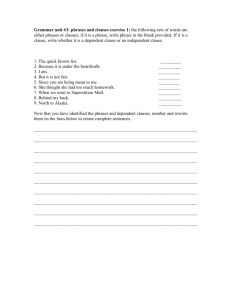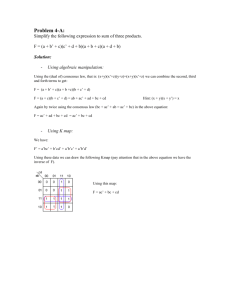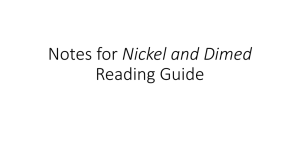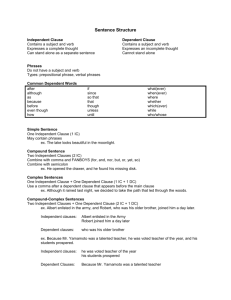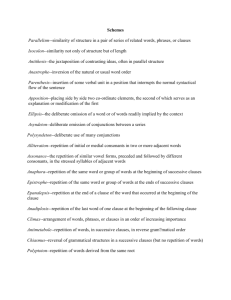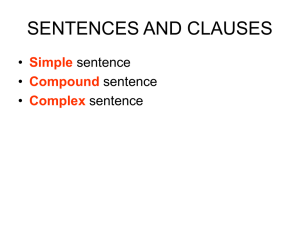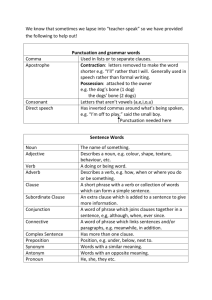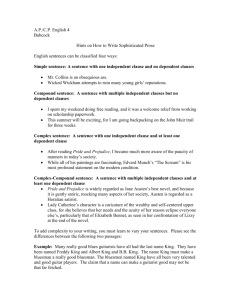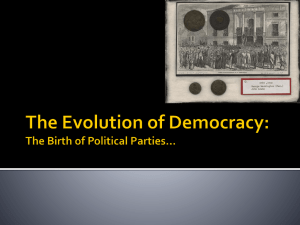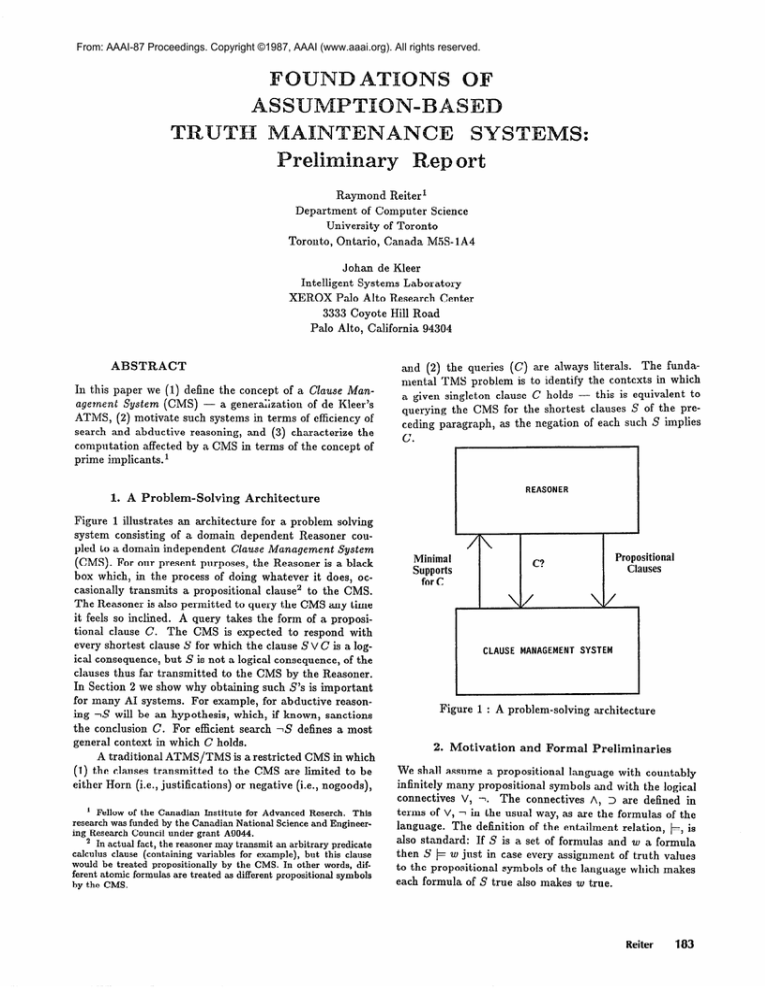
From: AAAI-87 Proceedings. Copyright ©1987, AAAI (www.aaai.org). All rights reserved.
rehminary
Raymond
Department
Reiterl
of Computer
University
Toronto,
Ontario,
Johan
Intelligent
XEROX
Canada
(CMS)
-
ATMS,
(2) motivate
such systems
and abductive
reasoning,
in terms
Man-
of de Kleer’s
of efficiency
<and (3) characterize
of
the
by a CMS in terms of the concept
1. A Problem-Solving
1 illustrates
of a Clause
a generalization
search
Figure
of
an architecture
for a problem
(C)
problem
it feels so inclined.
A query takes the form of a propositional clause C. The CMS is expected
to respond with
every shortest clause S for which the clause S V C is a logical consequence,
but S is not a logical consequence,
of the
clauses thus far transmitted
to the CMS by the Reasoner.
In Section 2 we show why obtaining
for many AI systems.
For example,
such S’s is important
for abductive
reason-
which,
the conclusion
C. For efficient search
general context in which C holds.
if known,
1s
sanctions
defines
a given singleton clause C holds querying the CMS for the shortest
ceding
paragraph,
as the negation
literals.
The
the contexts
funda-
in which
this is equivalent to
clauses S of the preof each such S implies
C.
Minimal
Supports
for c
I
CLAUSE
Figure
MANAGEMENT
SYSTEM
1 : A problem-solving
architecture
a most
2. Motivation
A traditional ATMS/TMS
is a restricted CMS in which
(1) the clauses transmitted
to the CMS are limited to be
or negative
are always
is to identify
solving
casionally
transmits
a propositional
clause2 to the CMS.
The Reasoner is also permitted to query the CMS any time
either Horn (i.e., justifications)
TMS
REASONER
(CMS). For our present purposes, the Reasoner is a black
box which, in the process of doing whatever it does, oc-
will be an hypothesis,
mental
Architecture
system consisting
of a domain dependent
Reasoner
coupled to a domain independent
Clause Management
System
ing 1s
94304
‘and (2) the queries
we (1) d e fi ne the concept
computation
affected
prime imp1icants.l
Center
Hill Road
California
ABSTRACT
System
Laboratory
Palo Alto Research
Palo Alto,
agement
M5S-lA4
de Kleer
Systems
3333 Coyote
In this paper
Science
of Toronto
(i.e., nogoods),
’ l?ellow of the Canadian Institute for Advanced Reserch. This
research was funded by the Canadian National Science and Engineering Research Council under grant A0044.
a In actual fact, the reasoner may transmit an arbitrary predicate
calculus clause (containing variables for example), but this clause
would be treated propositionally by the CMS. In other words, different atomic formulas are treated as different propositional symbols
by the CMS.
We shall assume
and Formal
a propositional
Preliminaries
language
with countably
infinitely many propositional
symbols and with the logical
connectives
V, 7
The connectives
A, 1 are defined in
terms of V, 1 in the usual way, as itre the formulas of the
language.
The definition of the entailment relation, I=, is
also standard:
If S is a set of formulas and w a formula
then S f= w just in case every assignment
of truth values
to the propositional
symbols of the language which makes
each formula
of S true also makes
w true.
Reiter
183
2.1.
which,
Definitions
A literal is a propositional
symbol
or the negation
propositional
symbol.
A clause is a finite disjunction
. . . V L,
of literals,
represent
clause,
clause
with no literal repeated.
a clause
denoted
We shall often
by the set of its literals.
by
is a tautology
{}
is the
clause
iff it contains
with
of a
Lr V
The
empty
no literals.
a propositional
A
symbol
and the negation of that propositional
symbol.
Let C be
a set of clauses, and C a clause. A clause S is a support
for C with
respect
to C iff C /& S and C b
a minimal
support
for C with
respect
by a back-chaining
inference
procedure
using
KB
as its
premises, but that these premises ,are insufficient to prove
g. Suppose the Reasoner recognizes this by its inability to
expand any of the leaf nodes in the search tree of Figure
2, which we shall use by way of an example4.
From this
the Reasoner
can conclude:
) An “or branch”
S is
to C iff no proper
subset of S is a support for C with respect
We can think of the CMS as a repository
(not necessarily
the Reasoner3.
S U C.
for simplicity
of exposition,
we take to be a set
Imagine further that the Reaof first order sentences.
soner has some goal formula g which it hopes to establish
to C.
for C -
some
all) of the conclusions
derived thus far by
A support clause S for C with respect to
} “and branches”
C has the properties:
1. CbSUCi.e.
Cb+3C.
2. C p S i.e.
C U (4’)
is satisfiable.
Property
1 tells us that the conjunction
of literals +
is
an hypothesis which, if known to C (and hence to the Reasoner)
cludes
would sanction the conclusion
hypotheses
inconsistent
with
C. Property
C since these
2 prewould
sanction
any conclusion
whatsoever.
Finally, a minimal
support clause S defines a shortest hypothesis
+’ which
_sanctions C or, as it were, a simplest conjecture from which
c follows.
We are now in a position
to specify the task which
a CMS is to achieve.
Recall that a’ CMS receives clauses
transmitted
to it by the Reasoner.
Let C be the set of such
clauses. Recall also, that the Reasoner may query the CMS
with a clause C. The task of a CMS is to determine all
minimal support clauses for C with respect to C. Ex<ample:
C = W4 4, rl, -h -cd, b, -9,
{-P,
Minimal
supports
for {p}
: {}.
Minimal
supports
for {}
: none.
Minimal
Minimal
Minimal
supports
supports
supports
for {q} : {s}, {r, -t},
for {p, q} : {}
for {s, r} : (q}, (1s},
q, 4,
Imagine
a reasoning
Automated Reasoning
KB, the Reasoner’s
current theory of the world, is inadequate to explain g (i.e., KB p g). The explanation
which
the Reasoner
transmits
to the CMS the three
inferred from Figure 2. The CMS now contains
supis a
since
the Reasoner
with some knowledge
base KB
3 Remember that the Reasoner decides, on its own pragmatic
grounds, which conclusions it transmits to the CMS and which it
withholds.
184
Now, suppose the reasoner is concerned with performing abduction, which is to say that it is seeking an explanation for g. Perhaps g is some observation
of the world and
(Tr).
Reasoning
system
KB bpv~qvg
/=qVvVg
are not the simplest possible explanations.
It is the job of a
CMS to provide such simplest explanations.
Accordingly,
two reasons:
Abductive
KB k=pAqxgi.e.
MB klqAr3gi.e.
{-a).
may have information
relevant to this question of simplicity which it has failed to transmit to the CMS, or perhaps
the Reasoner has failed to derive such relevant information. Why should a Reasoner find this notion of a minimal
support clause of any value to it all? There are at least
2.2.
search tree.
example of Figure 2, there are three such explanations
immediately at hand: p A q A r, up A q and lq A r. But these
simplest conjecture
from which C follows with respect to
what the CMS has been told about the knowledge
avail-S need not be a simplest conjecture
able to the Reasoner.
is concerned,
2 : A back-chaining
the Reasoner seeks is an hypothesis
which, together with
its background
knowledge KB, entails g. Trivially, for the
{q, r, -t}}
It is important
to observe that S being a minimal
port clause for C is relative to C. In other words, 4
so far as the Reasoner
Figure
KBkp//q~r~gi.e.KB+~pv~qV~-Vg
clauses C =
Reasoner
clauses it
the set of
&P, 1s --, d, {P,-a d, {a,Trydl- If the
now
queries
the CMS
with
the clause
{g}
the
CMS returns three minimal support
clauses of {g} with
respect to C, namely:
(lg),
{p, lq}, (lr>.
This means
C /= g 1 g and hence
KB
/= g 1 g,
CklpAq3gandhenceKB
/==pAqXg,and
C b r I g and hence KB /= r 1 g.
Thus, aside from the trivial explanation
simplest
explanations
for g, namely
g, there are two
up A q and r.
Notice that we have in mind here quite specific notions of “exnlanation”
and “simplest.”
Explanations
are
conjunctions
of ground literals. A simplest explanation
is
one for which no proper sub-conjunct
is an explanation.
Finally, we insist that explanations
be consistent with C,
4 We are assuming here that g is a ground literal, and that, although KB is a set of first order sentences, the leaf nodes of Figure
2 are-all ground literals.
for otherwise
Notice
we could
explain
also that a CMS,
3 : Let z = 0, compute
anything!
as defined,
is capable
of pro-
viding simplest explanations
only for q’s which are disjuncThis is clearly not as general as
tions of ground literals.
one might like. For example, the Reasoner could have two
observations
g1 and g2 of the world for which it wishes
e
simplest explanations
i.e., it wishes minimal conjuncts
such that
defined
C /= e 1 gi A g2 and C p le.
to handle
how a CMS
taken
this setting.
Our CMS
In the full paper
is not
we show
can.
Finally, with reference to Figure 2, notice that we have
the Reasoner to generate abductive
inferences by a
back-chaining
mechanism
which terminates
with leaves of
the search tree which cannot be expanded further.
While
4 : Let z =
1, compute
backtrack
7 : Let z = 1, compute
1.
c = es(l).
8 : Let x = 1, compute
a = er(l).
9 : Let y = 0, compute
b = e2(0).
10 : Let z = 0, compute
c = es(O).
10.
11 : Let z = 1, compute
c = es(l),
12 : Let y = 1, compute
b = en(l).
tions and 6 backtracks.
abductive
inferences
(e.g.,
track
Notice
c = es(l),
Now consider
this search.
reasoning
along
and proposals
the lines sketched
above.
for abductive
Representative
examples are residue resolution
[Finger, 19851, the THE19861, the hypothesis
generaORIST
system of [Poole,
tion formalism
of [Cox and Pietrzykowski,
19861, and the
NLAG
system
for learning
by analogy
by [Greiner,
19861.
equalities (e.g., ‘x =
the chronological
one with
this to the CMS.
Reasoner
checks
By
Efficient
exploiting
the
organize
and
control search,
much of the computation
of the Reasoner can be avoided.
Consider the following
sequence of statements
(from [de
Kleer,
to
861):
A:z~{o,i}
.l? : a = cl(x)
c
D:
is necessary
e2(y)
2 : Let y = 0, transmit
c # es(l).
backtrack
H:a#b
Suppose
backtracking:
expensive
it backtracks
for ex-
Before
is detected
in which
to the most recent vcariable assignment
of steps
choosing
(indicated
by a
proceeds.
If the vari-
y = 0 V y = 1, y # 0 V b = ez(0).
transmit a # el (0) V b # e2(0).
The
set is inconsistent,
so backtrack
to 2.
y # 1 V b = ez(1).
I, transmit 2 # 1 V c = es(l),
b # ez(I) V
so
Th e current choice set is inconsistent,
to 1.
8 : Let x = 1, transmit
x # 1 Vu
= cl(l).
9 : Let y = 0.
that the Reasoner is based on chronological
it processes the statements A through Hone
The sequence
two solutions
computations,
= (z + lOOOOO)!.
at a time until an inconsistency
change.
and conveys
3 : Let z = 0, transmit z - 0 V 2 = 1, 2 # 0 V c = es(O),
b # e2(0) V c # es(O). Th e current choice set is now
inconsistent,
so backtrack to 3.
7 : Let 2 =
ei(z)
Every
problem-solving
trace is:
1 : Let x = 0, transmit x = 0 V x = 1, x # 0 V a = el(0).
F:c=eg(z)
ample,
changes.
by x # OVa = el(0))
5 : y = 1 foll ows, transmit
ei require
the following
and processing
6 : T,et z = 0, solution.
functions
be used to improve
‘Let’ in the trace) a value for a variable, the Reasoner first
queries the CMS to see whether the variable is determined
If the variable is determined,
no
by the current choices.
E : x E (0,l)
G:b#c
The
might
computa-
Before performing
any computation,
the
to determine
whether the computation
4 : z = 1 follows,
current choice
: y E {O,l}
b=
14 expensive
able is not determined,
it chooses a value which can be
consistently
added to the current choice set. The resulting
Search
CMS
b # c, as a = b back-
does some computation,
it constructs
a
it (e.g., the computation
of a = ei(x)
has been done previously.
choice
2.3.
to
propositional
symbols all represent
1’). The new search is the same a;
from x = 0 is represented
to the Reasoner.
systems
As b = c backtrack
as b = c stop.
requires
how a CMS
The CMS
sumptions
are many
to
b # c, a # 6, solution.
c = es(O),
that this approach
time the Reasoner
clause representing
acceptable
As b = c backtrack
to 13.
[Cox and Pietrzykowski,
19861). Again, such unresolved
literals may be determined
by a prespecified
class of asThere
b so
b = ez(1).
fine a class of acceptable
assumptions
Back-chaining
is prepared to make.
can support
a =
c = es(O), b # c, a # b, solution.
14 : Let z = 1, compute
refutations
b # c but
c = es(l),
5 : Let y = 1, compute
guished set of literals which, in a back-chaining
search,
For the Reasoner,
such literals deare never expanded.
pleted
to
6 : Let z = 0, compute
13 : Let z = 0, compute
can define resolution theorem-provers
with suitable termination conditions.
The unresolved
literals of the uncom-
As b = c backtrack
to 2.
this is one possible mechanism,
others are also possible.
For example, the Reasoner may have defined some distin-
which the Reasoner
is not essential; one
c = es(O).
R
it might
are as follows:
follow
case
it can
to End the
10 : 2 = 1 follows,
solution.
11 : Let y = 1, transmit a f el(l)Vb
# ez(I).
choice set is inconsistent,
so stop.
The current
From this example we can see some of the advantages
of
a CMS-guided
search. Intuitively,
the CMS is functioning
a = er(0).
as an intelligent cache. For this example,
requires 6, not 14 expensive computations,
CMS-approach
1 : Let 5 = 0, compute
2 : Let y = 0, compute
b = ez(0).
tracks,
this particular
and
8, not
14 choices.
Note
that
3, not 5 back-
Reiter
185
search
a CMS
example
-
exploits
we present
only
a few of the capabilities
it only as an illustration
of
of how a
Unfortunately,
the converse
the following example shows:
CMS could be utilized.
It is relatively
simple to invent
a strategy for this particular
problem which achieves the
same efficiency, however, the CMS provides a general
cility that achieves these advantages for <any Reasoner.
fa-
The CMS performs many of the functions of a conventional TMS [Doyle, 791 [Doyle, 831 [McAllester,
801. Their
advantages
cussed
(and disadvantages)
elsewhere
(e.g.,
3. Prime
Implicants
A prime
Definition.
clause
have been extensively
[de Kleer,
implicant
dis-
861).
of a set C of clauses
is a
The prime
The concept
problem
subset
C’ of C does C k C’.
of a prime implicant
of two-level
circuits
[Birkoff
Boolean
and Bartee
arises in solving
minimization
1970,
Ch.
the
of switching
61.
In this
set-
ting, one is required to synthesize a given Boolean function
in sum-of-products
form using the fewest total number of
and-gates and or-gates.
Our definition of prime implicant
is the dual of that used in Boolean minimization,
basically
because for us, the Boolean function is represented
by C,
a set of clauses, and hence is in product-of-sums
form. Dewe shall use the same terminology
spite this difference,
since formally both concepts share the
“prime implicant”
same properties
modulo
the duality
between
V and A.
Notice that if C p p and C b lp for some propositional symbol p, then the tautology
p V lp is a prime
implicant of C.
The following
result
is straightforward:
Proposition
1. If C is a set of clauses
then C /= C iff there is a prime implicant
implicants
c2))
of c are:
{Pl,Tl},
{p2,7p2},
etc.
{Pi9C1)7 -IPisP2,C2),
The prime inlplicant II = {pl, ~2, c2} satisfies II n c + (1,
but II - C = {pl,p2}
is not a minimal support clause for
C with respect to C.
There is, however,
Theorem 2:
an important
partial
converse
of
and C a clause,
of C which
is a
Theorem
3. Let C be a set of clauses and C a non-empty
If lI is a prime implicant of C such that C c SI,
clause.
then II - C is a minimal
support
clause for C with respect
to c.
Proof.
We must prove that C p II - C, which is obvious,
and that C b
(II - C) UC
which is equally
obvious.
QED.
A unit clause is a clause with just one literal.
Definition.
A simple
lowing:
consequence
of Theorems
2 and 3 is the fol-
Corollary
4. Let C be a set of clauses and C = (!) a
Then S is a minimal
support clause for C
unit clause.
with respect to C i$ there is a prime implicant lI of C such
that e E IfI and S = II - {L}.
of C.
Theorem
2. Suppose
C is a set of clauses
and C a clause.
If
S is a minimal support clause for C with respect
then there is a prime imp&ant
II of C such that IInC
to C
# ()
andS==H-C.
Proof.
We know that C /= S U C.
Moreover,
by the
minimality of S, we know that SnC
= (1. By Proposition
1, there is a prime implicant II of C such that II C S U C,
say II = S’ U C’ where S’ C S and C’ C C. We prove
first that C’ # {} f rom which it follows that II n C # {}.
For if C’ = {} th en II C S and since C + II it must be
that C k S which contradicts
S being a support clause
for C with respect to C. Finally, we prove that S’ = S, so
Corollary
allow us to generalize
qc,c>
JJnc
{SlS
the minimal
sup-
clauses
5.
MIN-SUPPORTS
considerably.
C is a set of clauses
{II - q-I
E n(C,
is a proper
S, which
Automated Reasoning
=
his system
# 01
MIN-SUPPORTS(C,
Theorem
of S. QED.
When
Notation.
since C k II and C’ C C then C /= S’ U C. But then S’
is a smaller support clause for C with respect to C than is
the minimality
characterizes
provides a characterization
of de Kleer’s [1986] Assumption Based Truth Maintenance
System.
Moreover,
it will
contrary and obtain a contradiction.
So, suppose S’ is a
proper subset of S. Since C F S then C k S’. Moreover,
contradicts
4 completely
port clauses in the case of unit queries issued by the Reasoner to the CMS. As we shall see in Section 5, this result
that II = S U C’ and since S n C = {} and C’ C C it will
follow that S = II - C. To prove S’ = S we assume the
186
Pa,
2 is false, as
C such that
1. C j= C, and
2. For no proper
subset
c = {{Pl, 4&l,
c = lc*.c3J
I -I a,
of Theorem
is a prime
and C a clause,
implicant
of C and
C) =
C) and no clause
subset
(Characterization
ofn(C,
C)
of S}.
of minimal
support
(C, C) is the set of all minimal
of C with respect
to C.
clauses.)
support
By Theorem
Proof.
2, if S is a minimal
support
clause of
the prime
Boolean
trary, for some proper
many
subset
S’ of S, that
S’ E n(C,
impliccants
an explosive
C with respect to C then S E n(C, C). We must prove that
no proper subset of S is in n(C, C). Suppose to the conC).
This
is potentially
It can be shown that there are
in n variables with exponentially
(in n)
functions
prime
of these clauses.
approach.
implicants.
Moreover,
CMS
updates
We shall prove that S’ is a support clause for C with respect to C, contradicting
the minimality
of S. Clearly,
very expensive since, if C is the CMS’s current
(consisting
of the prime implicants of all clauses
since C tfr S and S’ C S, C i# S’. It remains to show that
C+S’uC.
NowS’=I-I
- C for some prime implicant II.
Reasoner,
{K}.
Thus, S’UC = (fl-C)UC
> II. Since C /= II, C k S’UC.
Hence, S’ is a support clause for C with respect to C.
Now suppose S E MIN-SUPPORTS
(C, C). We must
prove that S is a minimal support clause for C with respect
to C, i.e., that
1. c t&s,
Proof
subset ,of S has properties
S =
II -
C for some prime implicant
H of C
such that II r) C # {}, S is a proper subset of II. Because
H is a prime implicant
Proof of 2:
of C, C /# S.
Since S = II - C for some prime implicant
(IT - C) u c z, II. s ince C b II, C + S U C.
Proof of 3:
II, S U C =
Assume to the contrary that S has a proper subset
with property 2, i.e., that C k S’ U C. By Proposition
of this approach, by Theorem
support clauses is cheap.
S’ 17 C = {}. Hence, since H C S’ U C, II - C C S’ which
is a proper subset of 5’; since II’ - C E n(C, C), S $!
(C, C), contradiction.
vs.
The
Interpreted
Compiled
Approach
The simplest storage mechanism
is to encode the Reasoner’s clauses just as they are, possibly
indexed by the
literals
they contain for more efficient content addressable
Thus, updating
the CMS’s database with a new
access.
clause is quick and simple. The price one pays for this sim-
plicity
of storage
is a high retrieval
cost.
Theorem
6. Suppose C is a set of clauses.
Then C and
PI(C)
are logically equivalent in the sense that if C E C,
then PI(C)
Proof.
b C,
Theorem 5, and this can be an expensive conlputation.5
the Reasoner is expected to issue many CMS updates
If
but
few queries, then this interpreted
approach
will be warranted. In the full paper we shall describe and justify an
for computing
MIN-SUPPORTS
6 justifies
Compiled
then C /= C.
the compiled
implicants
database.
In the full paper
approach
of the Reasoner’s
we shall describe
of storing
clauses
in the
and justify
an al-
gorithm for updating
a compiled
CMS database
i.e.,
computing
the prim e implicants
of C U {K}
assuming
already have all prime implicants of C.
for
we
ATMS:
A Reconstruction
Truth Maintenance
De Kleer’s 119861 A ssumption-Based
is a CMS constrained
to process so-called
System (ATMS)
Horn clauses. Moreover, the ATMS requires that the propositional symbols have a distinguished
subset called assumptions. From the standpoint of the Reasoner, an assumption
might be one of the distinguished
propositional
symbols
which it is prepared to propose as part of an hypothesis
to explain an observation
in abductive
reasoning (Section
2), or one of the propositional
symbols forming part of
a proposed
(Section
solution
to a constraint
satisfaction
problem
2).
(C, C).
Definition.
A Horn clause
Approach
Under this approach,
the CMS does not store the clauses
transmitted
to it by the Reasoner.
Tnstead, it stores all
5 Jn fact, it is easy to show that the general problem is NP-hard.
is a clause
in which
at most
one propositional
symbol occurs unnegated.
The general form of a Horn Clause is 1~1 V -a.V ~p,Vp
for propositional
744
2 0.
Recall that,
symbols
p, pl, . - .p,,
for the purposes
there is a distinguished
called assumptions.
4.2 The
C E PI(C)
Trivial.
only the prime
CMS
if
and
To find all min-
imal support clauses for C with respect to C, the CMS’s
database requires computing
MTN-SUPPORTS
(C, C) by
algorithm
of minimal
QED.
There are two natural ways the CMS can store information
and process queries issued to it by the Reasoner.
4.1
5, is that retrieval
equivalent.
5. De Kleer’s
4. Interpreted
of CU
and time complexity
The first thing we must show is that there is no loss
of information
in representing
a set C of clauses by PI(C)
the set of its prime implicants,
i.e., that C and PI(C)
are
Theorem
S’
1,
C has a prime implicant II’ C S’ UC. Since S = II - C for
some prime implicant
H of C, S fl C = {}. Since S’ G S,
MIN-SUPPORTS
all the prime implicants
for the high space
1 and 2.
of 1:
Since
thus far), and K is a new clause issued by the
we must compute
The reward
logically
2. Ct=SuC,and
3. No proper
the Reasoner
can be
database
issued by
n 2 0, or lpi
of de Kleer’s
ATMS,
subset of the propositional
We denote
assumptions
V a. . V
symbols
by upper-case
A’s, usually subscripted,
non-assumption
propositional
symbols by lower case p’s, and when the distinction
+ unimportant by lower-case CX’S.
In de Kleer’s approach,
to transmit
to the ATMS
the Reasoner
only
Horn
is constrained
clauses.
De Kleer
Reiter
187
calls such transmitted
clause
Horn clauses justifications.
When
a
has the form
consequent
1~1 V - - e V T(Y~ V (Y, cx is called the
of the clause, and (~1, - * -(Y, the antecedents
of
the clause.
If n = 0, the consequence
When formulated
the following:
in our terms,
cx is called a premise.
the task of the ATMS
such approaches
in the literature, e.g., [Minicozzi and Reiter, 19721 [Sl a gl e et al., 19691). The full paper considers
the appropriateness
termining
prime
of these and other
algorithms
for de-
implicants.
is
References
transmitted
thus far
Given J, the set of justifications
to the ATMS by the Reasoner, and cr, a propositional
sym-
[Birkhoff
and Bartee,
19701 G. Birkhoff
‘and T.C.
Bar-
bol (which may or may not be an assumption),
compute
(Al A. . . A A,] (~AI, . . ., lAn}
is a minimal support clause
tee.
for {a}
[Cox and Pietrzykowski,
19861 P.T. Cox and T. Pietryzkowski.
Causes for events: their computation
and ap-
This
with respect
set is what
to J}.
de Kleer
plete and minimal label
provides the following:
calls a consistent,
for Q.
Corollary
sound,
com-
4 immediately
Theorem
7. (Characterization
of de Kleer’s ATMS)
Suppose that J is the set of justifications
transmitted
the A TMS by the Reasoner,
cy is a propositional
symbol
assumption).
Then
{Al A.. - r\A,[k>O
Applied
Algebra.
McGraw-IIill,
New
York,
1970.
plications.
In Proc. 8th Int. Conf. on Autom.
Deduction
and Lecture Notes in Computer
Science
2.90, pages 608621, Springer-Verlag,
1986.
[de Kleer, 1986j J. de Kleer.
to
and that {(;Y} is a query, where
(which may or may not be an
the answers to this query
andTA1V...VTAkVcr
Modern
are given by
is a prime
imp&cant of J).
In the full paper we characterize
the algorithm used
by de Kleer’s ATMS, and prove its correctness with respect
to Theorem 7.
TMS.
Artificial
Intelligence
28
An
assumption-based
127-162,
1968.
[Doyle, 19791 J. Doyle. A truth maintenance
Artificial Intelligence
12 231-272,
1979.
[Doyle,
sumptions:
10831 J. Doyle. Some
An essay in rational
system.
theories of reasoned aspsychology.
CS-83-125,
Department
of Computer
Science, C.M.U.,
1983.
[Finger, 19851 J.J. Finger.
Residue:
a deductive
proach to design
1035, Knowledge
synthesis.
Technical
Systems Laboratory,
ap-
Report Stan-CS-85Stanford University,
1985.
6.
Generalizing
the
[Greiner,
ATMS
ing analogies.
We can immediately
see various ways to generalize de Kleer’s
ATMS. To begin, justifications
need not be Horn clauses.
Thus we can define a justification
to be any clause
fa1
V cy, where
v * * ’ V fa,
n > 0 and each
Technical
Report
Learning
CSRI-188,
by understandDepartment
maintenance.
cy is a
M.I.T.,
1980.
[Minicozzi
AIM-551,
Artificial
and Reiter,
Intelligence
19721 E. Minicozzi
Laboratory,
and R. Re-
propositional
symbol which may or may not be an assumption.
Moreover, the consequence
(Y need not be atomic.
We can
iter. A note on linear resolution
allow la! as a consequence,
sis as theory formation.
Department
of Computer
Techical Report CS-86-08, University of Waterloo,
or more
generally,
fak
can be taken to be a consequence.
can be arbitrary clauses, not necessarily,
fcvr V - - - V
Finally, queries
as in de Kleer’s
ATMS, unit clauses. In the full paper, we elaborate on such
possible generalizations.
Notice that Theorem 5 characterizes query evaluation
7. A Word
The results
for any such generalization.
on Computing
of this paper
Prime
rely on computing
all, or some,
prime implicants
of set C of propositional
clauses.
theory of switching
circuit Boolean
minimization,
In the
prime
implicants are computed using the consensus method [Birkhoff and Bartee, 1970, Ch. 61. Since our notion of prime
implicant
concerned
is the dual of that for switching theory,
with the dual of the conserbsus method,
we are
which
turns out to be resolution
[Robinson,
19651. A brute force
way of computing
all prime implicants
of C is to resolve
pairs of clauses of C, add the resolvents to C, delete subsumed clauses and repeat until no fresh clauses are obtained.
cants
The resulting
of C.
Obviously,
clauses
are all of the prime
WC prefer
proach
to computing
prime
18%
Automated Reasoning
a more
implicants.
disciplined
There
strategies
in consequence-
finding. Artificial Intelligence
3 175-180,
1972.
[Poole, 19861 D. Poole. Default reasoning
and diagno-
impliap-
are a few
Science
1986.
[Robinson,
19651 J.A. Robinson.
A machine-oriented
logic based on the resolution principle.
J. ACM 12 23-41,
1965.
[Slagle et al., 19691 J.R. Slagle, C.L. Chang,
Pmplicants
of
Computer
Science, University of Toronto,
1986.
[McAllester,
19801 D. McAllester.
An outlook on truth
of the
form
19861 R. Greiner.
and R.C.T.
Lee, Completeness
theorems for semantic resolution in consequence-Ending.
In Proceedings
IJCAI-69,
pages 281--285,
Washington,
D.C., 1969.

